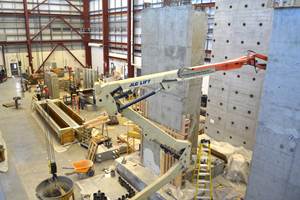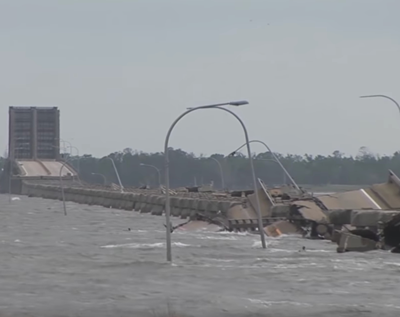Why aren't composites synonymous with infrastructure?
The U.S. seems poised to invest heavily in infrastructure. Can the composites industry rise to the occasion?

Photo Credit: Mateenbar
The word “infrastructure” is getting a lot of use these days. This is driven primarily by legislation pending in the U.S. Congress that was proposed by President Biden. It seeks to invest as much as $4 trillion in infrastructure-related projects and programs. While it’s unlikely the president will see the entirety of his proposal come to fruition, a compromise of some sort with congressional Republicans seems possible and would result in a significant increase in spending on American infrastructure, ranging from bridges and roads to railways and waterways.
The prospect of investing billions of dollars in infrastructure programs has civil engineers throughout the country dreaming about finally tackling infrastructure repair and restoration projects that have been neglected for many years. And, more importantly, it has composites professionals wondering if we have finally reached a tipping point in the use of composite materials in infrastructure applications.
Of course, such wishful thinking is not new. Since well before I joined CW in 2006, the infrastructure market has been the Holy Grail of composites use. The ease of application, strength, durability and corrosion resistance of composites make them a nearly ideal solution for bridge repair, concrete reinforcement, marine structure protection, train platform construction, utility poles, water delivery systems and much more. In fact, it’s difficult to look at the installation, mechanical and environmental requirements of infrastructure materials and not be amazed that composites have made so little headway in this end market.
Increasing emphasis in government agencies and departments of transportation on sustainability, carbon emissions targets and lifecycle outcomes is tilting the materials argument — very slowly — in favor of composites.
Why is this so? We have heard a few objections over the years. First, civil engineers in general and departments of transportation in particular are woefully lacking in materials knowledge outside of concrete and steel. It is rare that an engineering education includes more than a passing reference to advanced materials like composites, so it’s difficult to expect engineers to embrace composite materials.
The second objection is related to the first and revolves around codes and standards. Because composites are so foreign to civil engineers, standards are rarely developed to guide engineers on the use of composites in infrastructure projects. There are exceptions — which only prove the rule — in some places. The Florida Department of Transportation (FDOT), for example, is famous for its embrace of composite materials, particularly in or near waterways, of which there are many in Florida. The Tennessee Department of Transportation (TDOT) has also demonstrated willingness to work with composites. The composites industry can and must lead the way in developing standards that can be readily adopted by the infrastructure community.
Not surprisingly, the third objection revolves around cost. For many years, the relatively high “first cost” of composites compared to steel and concrete was a nonstarter. Many departments of transportation were unwilling to pay more up front for an advanced material, even if that advanced material offered better mechanical performance, made the finished product more durable and reduced overall maintenance. In short, the strong lifecycle cost argument in favor of composites was outweighed by their relatively high purchase price.
However, we are seeing this start to change. Increasing emphasis in government agencies and departments of transportation on sustainability, carbon emissions targets and lifecycle outcomes is tilting the materials argument — very slowly — in favor of composites. It also helps that there have been, in the last few years, some very high-profile infrastructure projects that made significant use of composites. Curent exhibit number one in support of this argument is the Jizan flood mitigation channel in Saudi Arabia, which uses 11,000 kilometers of GFRP rebar to reinforce a concrete channel that is 23 kilometers long and 800 meters wide.
There are a number of organizations advocating for composites use in infrastructure and working on standards development. Leading the way is the American Composites Manufacturers Assn. (ACMA, Arlington, Va., U.S.), which has a committee devoted to the effort. This work will require coordination with the American Society of Civil Engineers (Reston, Va., U.S.) and the American Concrete Institute (Indianapolis, Ind., U.S.).
Clearly composites have a compelling story to tell civil engineers. However, they must be not only receptive to story, but also have the tools to bring that story to life. There is still work to do, but the opportunity is before us. I believe we are at an infrastructure inflection point for composites and hope this is the start of a new era in composites use. I encourage you to get involved if you want to help the cause.
This article was originally published 5/31/2021, updated 7/12/2022
Related Content
KU researchers explore FRP materials for dams, levee reinforcement
To address aging infrastructure, a team of researchers at KU is conducting research into repairing and retrofitting 700-plus dams, levees and related structures nationwide using FRP materials.
Read MoreCCG FRP panels rehabilitate historic Northamption Street Bridge
High-strength, composite molded, prefabricated panels solve weight problems for the heavily-trafficked bridge, providing cantilever sidewalks for wider shared use paths.
Read MoreCCG meets customer demand with StormStrong utility pole lineup
Additional diameters build on the portfolio of resilient FRP pole structures for distribution and light pole customers.
Read MoreSwedish parking garage to incorporate decommissioned wind blades
Architect Jonas Lloyd is working with Vattenfall to design the multistory building with a wind blade façade, targeting eco-friendly buildings and creative ways to remove blades from landfills.
Read MoreRead Next
ACMA announces 2020 Infrastructure Day
ACMA’s fifth Infrastructure Day in Feb. 2020 will gather political and composites manufacturing leaders in Washington D.C. to discuss infrastructure legislation.
Read MoreResilient infrastructure: Starting the dialogue
How does the infrastructure industry — and composites in particular — combat more frequent severe weather events and tidal flooding in coastal communities? Columnist Dale Brosius documents the beginnings of that dialogue.
Read MorePlant tour: Daher Shap’in TechCenter and composites production plant, Saint-Aignan-de-Grandlieu, France
Co-located R&D and production advance OOA thermosets, thermoplastics, welding, recycling and digital technologies for faster processing and certification of lighter, more sustainable composites.
Read More





















